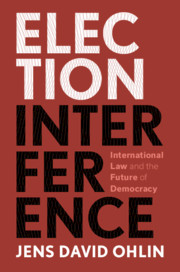Book contents
- Election Interference
- Election Interference
- Copyright page
- Dedication
- Contents
- Acknowledgements
- Introduction
- 1 What Is Election Interference?
- 2 Election Interference Is Not Cyber-War
- 3 Limits of the Sovereignty Framework
- 4 The Promise of Self-Determination
- 5 Foreign Electioneering and Transparency
- 6 Free Speech and Elections
- 7 The Value of Criminal Prosecutions
- 8 Soliciting Foreign Interference
- Conclusion
- Index
1 - What Is Election Interference?
Published online by Cambridge University Press: 09 June 2020
- Election Interference
- Election Interference
- Copyright page
- Dedication
- Contents
- Acknowledgements
- Introduction
- 1 What Is Election Interference?
- 2 Election Interference Is Not Cyber-War
- 3 Limits of the Sovereignty Framework
- 4 The Promise of Self-Determination
- 5 Foreign Electioneering and Transparency
- 6 Free Speech and Elections
- 7 The Value of Criminal Prosecutions
- 8 Soliciting Foreign Interference
- Conclusion
- Index
Summary
Russian interference in the 2016 election was not an isolated event but was, rather, a cluster of related techniques, each of which will be described in this chapter. There is wide agreement in government and intelligence circles about what happened, though the Trump administration has at times stated contradictory things about whether the interference occurred, or contradictory characterizations of the interference. There was: (1) hacking of email accounts and the public release of information stolen from these accounts; (2) social media campaigns, including paid advertisements on Facebook and postings on Twitter engineered by so-called troll farms; and (3) the infiltration of advocacy organizations such as the National Rifle Association, with the goal of influencing the domestic political landscape. These activities raise two important issues that are analyzed in this chapter. First, are the actors who engage in this interference private actors or state agents, and does it make a difference? Second, based on the methods used, what conclusions can be drawn about Russia’s strategic objectives in interfering in the 2016 elections? These questions must be answered in order to answer the fundamental question, i.e., whether election interference violates international law, and if yes, in what way.
Keywords
- Type
- Chapter
- Information
- Election InterferenceInternational Law and the Future of Democracy, pp. 10 - 39Publisher: Cambridge University PressPrint publication year: 2020



